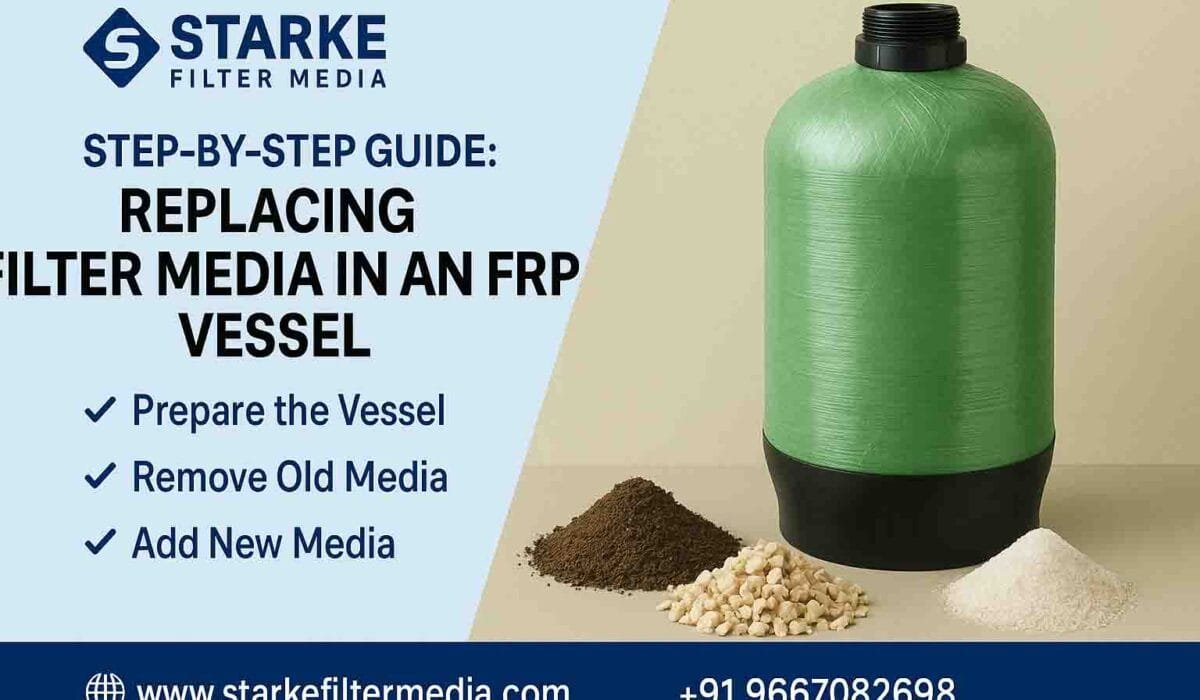Why Replacing Filter Media Is Critical for Filter Performance
Over time, all filter media lose effectiveness due to:
Clogging by suspended solids
Biofilm growth
Media breakdown or channeling
Loss of adsorption capacity (especially carbon or iron removal media)
Ignoring timely media replacement leads to:
Reduced filtration efficiency
Pressure drop
Contaminated output water
Damage to downstream RO membranes or UV units
This guide helps you replace media the right way without damaging your FRP vessel or losing time.
What Is an FRP Vessel?
FRP (Fiberglass Reinforced Plastic) vessels are widely used in:
Industrial and commercial water treatment
Softening, iron removal, RO pre-treatment
Domestic filtration setups
They are:
Lightweight
Corrosion-resistant
Pressure-resistant (up to 10 bar)
But the performance depends on the quality and condition of the filter media inside.
Tools & Materials You’ll Need
✔ Pipe wrench or spanner
✔ Funnel or scoop
✔ Garden hose or water jet
✔ Media removal vacuum (optional for large filters)
✔ New filter media (sand, carbon, Purozite, etc.)
✔ Filter gravel (if base support is required)
✔ PPE gloves and mask
✔ TDS or iron test kit (for final validation)
Step-by-Step: How to Replace Filter Media in an FRP Vessel
Step 1: Shut Off Water Supply & Depressurize
Close inlet and outlet valves.
Open the drain or relief valve to release pressure.
Wait until the vessel is safe to handle.
Step 2: Remove the Head or Valve
Unscrew or unbolt the valve on top.
Be careful not to damage the riser pipe or distributor.
Step 3: Remove Used Filter Media
Use a scoop or vacuum to remove old media.
If using gravel base, clean and reuse it if not degraded.
Rinse the tank thoroughly with clean water.
Step 4: Check Internal Components
Inspect the central riser, hub & lateral distributor for cracks or blockages.
Replace damaged internals to avoid bypass or flow issues.
Step 5: Load New Media Carefully
First, add filter gravel if required.
Use a funnel to load media slowly to avoid damaging the riser pipe.
Typical layer sequence (for multi-media filters):
Gravel base
Coarse media (e.g., Garnet)
Fine media (e.g., Sand, Purozite, Activated Carbon)
Step 6: Refit Valve & Tighten Seals
Ensure riser is aligned with the top valve.
Tighten the top cover/valve securely.
Step 7: Backwash the Media
Turn on water in backwash mode slowly.
Let the water flow until it runs clean (usually 10–15 minutes).
This removes dust and allows media to settle properly.
Step 8: Test Output Water
Run in service mode and collect output water.
Check for TDS, turbidity, or iron content as applicable.
How Often Should You Replace Filter Media?
| Media Type | Typical Replacement Frequency |
|---|---|
| Filter Sand | 2–3 years |
| Activated Carbon | 6–12 months |
| Purozite | 3–5 years |
| Iron Removal Media | 2–5 years (depends on MnO₂ %) |
| Gravel | 5–7 years |
Pro Tip from Starke Engineers
Always replace media during plant shutdown or low-demand periods. Keep spare parts and extra media stock on site for quick turnaround. Use media with certifications like AWWA B100 or NSF for better filtration performance.
Starke’s Ready-to-Use Filter Media for FRP Vessels
| Media | Key Features |
|---|---|
| Starke Filter Sand | Graded, washed, AWWA B100 compliant |
| StarMnox® MnO₂ | High iron removal, >98 % pure |
| Purozite® | Replaces zeolite; high filtration & longevity |
| Coconut Shell Carbon | High iodine value, long life |
| Calcite | pH correction for acidic water |
| Garnet | For multi-layer bed setup (bottom layer) |
All media available in 25/50 kg bags with technical support.
Frequently Asked Questions
Q1. Can I mix old and new media?
It is not recommended, as aged media may reduce the performance of new media and cause uneven flow.
Q2. What is the correct layer thickness in an FRP filter?
Typical bed depth is 600–1000 mm. Each layer (if multi-media) should be 150–300 mm thick.
Q3. How to know if my media is exhausted?
Look for high turbidity, low flow rate, iron color stains, and reduced water clarity.
Q4. Can I do this replacement myself?
Yes—for domestic filters. For industrial plants, consult a technician or Starke’s support team.
Need help choosing the right filter media or planning your FRP vessel refill?
Reach out to our technical team or request a quotation today.
Email: info@starkefiltermedia.com
Website: www.starkefiltermedia.com

